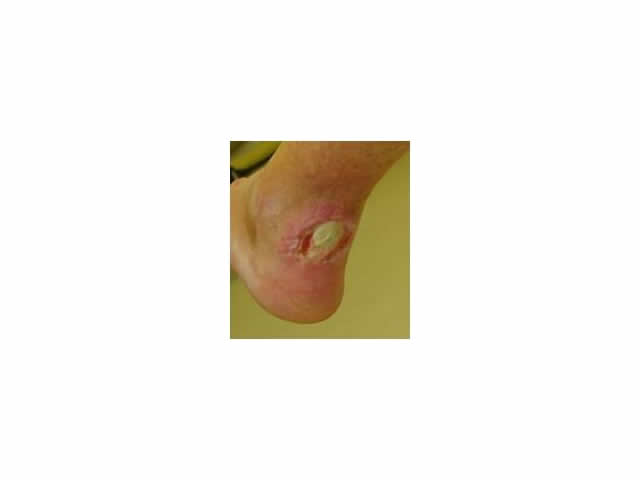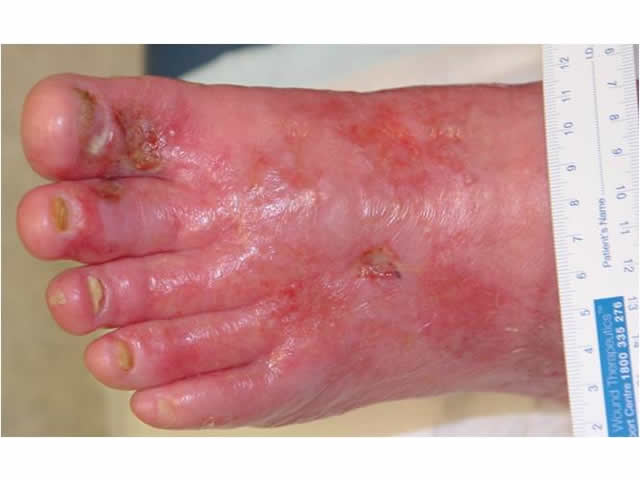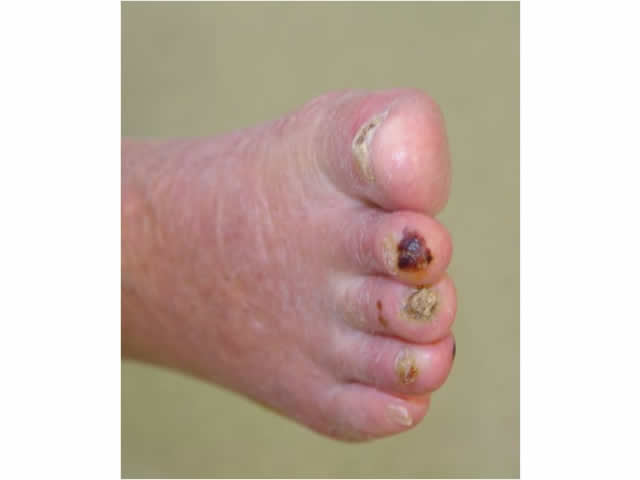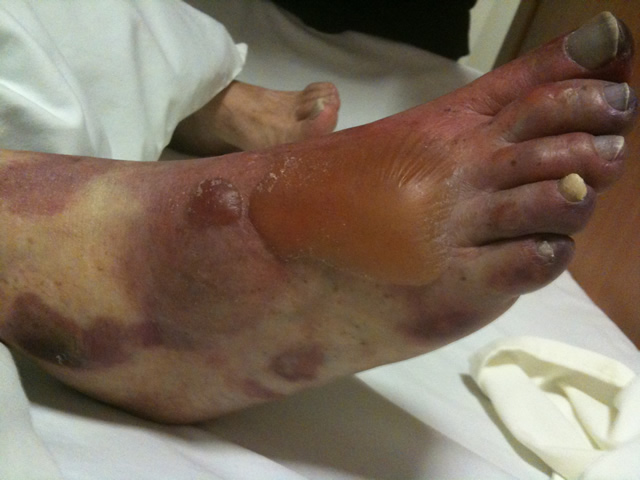4A: Assessment
This section covers:
What is an arterial leg ulcer?
Arterial leg ulcers are less common than venous leg ulcers and are the result of arterial disease.
Arteries supply blood and oxygen to the lower limbs. Arterial leg ulcers result from inadequate blood supply and oxygen in the arteries. If blood supply to the lower legs is poor, the leg is starved of oxygen and nutrients and the skin fails to function normally. As a result, an ulcer may develop.
A client with arterial disease may have very cool or cold feet, the skin may be pale, blue (cyanosed) or dusky red in colour and they may complain of pain in the foot or calf muscle. Pain is often worse at night when the lower leg is elevated in bed and pain is only relieved when the legs are lowered. During exercise, the muscles in the lower leg need more oxygen and when a person has arterial disease, the blood supply is decreased and pain occurs in the foot or calf muscle. This pain is known as “intermittent claudication”.
IMAGE - M4 01 Arterial leg ulcerRisk Factors
The risk factors for arterial leg ulcers are explained further in the following table.
| Risk factor | Explanation |
| Hardening or blockages in the arteries (atherosclerosis) | Hardening, narrowing or blockage of the arteries because of fatty deposits (plaques) or cholesterol reduces blood supply to the lower leg. |
| Smoking | Cigarette smoking is a well known risk factor for hardening of the arteries (atherosclerosis) and ischaemic heart disease. |
| High blood pressure (hypertension) | High blood pressure leads to hardening of the arteries. |
| Diabetes | Poorly controlled diabetes leads to high cholesterol levels in the blood and increased risk of hardening of the arteries. There is also an increased risk of strokes, heart disease and ulceration of the lower limbs. This is discussed further in Module 5. |
| High cholesterol | High cholesterol is a major risk factor for hardening of the arteries. |
| Stress | There is a link between high levels of stress and arterial disease. |
| A history of heart disease, heart attack or stroke | These conditions increase the risk of further problems with the arteries. |
| Obesity | Excess weight, particularly around the waist and thighs, puts extra pressure on the arteries and the heart has to work harder to move blood around the body. |
Characteristics
Every leg ulcer has key features or characteristics that can help you determine the type of leg ulcer the person may be suffering from. The key characteristics of arterial leg ulcers are outlined in the following table.
| Factor | Arterial leg ulcer details |
| Wound location | Arterial leg ulcers usually affect the toes or shin, or occur over pressure points (i.e. sites subjected to trauma, the rubbing of footwear and ankle bones). IMAGE - M4 02 Arterial leg ulcer |
| Wound depth | Arterial leg ulcers are usually shallow but may be deep. |
| Appearance of wound bed | The wound bed is usually pale grey or yellow in colour with no evidence of new tissue growth present. It may also be black (necrotic) and tendons may be exposed. IMAGE - M4 03 Achilles tendon exposed |
| Wound shape and margins | Arterial leg ulcers are usually described as having a smooth, even or punched out appearance. The shape of the wound may conform to injury if caused by trauma. IMAGE - M4 04 Punched out appearance of wound |
| Wound leakage (exudate) | Arterial leg ulcers produce low amounts of leakage (exudate). |
| Surrounding skin | The surrounding skin has many characteristics that help us to categorise the leg ulcer as one of arterial origin including:
|
| Pain levels | Arterial leg ulcers are often accompanied by severe cramping pain in the foot or calf muscle at rest when the legs are elevated. Pain may also increase when walking short distances (known as “intermittent claudication”). |
How to assess
Being able to recognise the key signs and symptoms of an arterial leg ulcer is very important to help diagnose an arterial leg ulcer accurately. However, there are several important steps that must also be performed. These include:
| Step | Explanation |
| 1. Obtain the client’s health history | This includes a history of the present leg ulcer or symptoms. You might like to ask:
It is also important to ask about general medical conditions the person may have, especially heart disease, high blood pressure or cerebrovascular accident, smoking history, mobility, medication and nutritional status. |
| 2. Examine the client’s legs | Look at the legs and note if there is any swelling. You need to be able to answer these questions:
|
| 3. Examine the client’s foot pulses | You need to palpate(touch) foot pulses, particularly the pulse located on top of the foot (known as the “dorsalis pedis pulse”). If this pulse feels weak on palpation , this indicates poor blood flow to the lower limb. |
| 4. Examine the ulcer | Measure the size of the ulcer at least every four weeks or if there is any rapid improvement or deterioration in wound size. This helps to determine if your treatment is working or not.
Note the presence of any smell, the colour of the wound bed, how much exudate or leakage the wound is producing and the condition of surrounding skin. Also, note the characteristics of the wound margin. Arterial leg ulcers have punched out wound margins. |
| 5. Measure the Doppler Ankle Brachial Pressure Index (ABPI) | A trained health professional should carry out a hand-held Doppler Ankle Brachial Pressure Index (ABPI) examination. This involves first performing a blood pressure test on both arms and both legs and listening to the arteries with an ultrasound machine, and then comparing the ankle and brachial systolic pressures. This test helps to determine the type of treatment the client may need or if they need to be referred to a specialist for further investigation. |
When to refer
It is very important that you refer your client to a specialist when:
- There is uncertainty in diagnosis (i.e. it is difficult to determine the type of ulcer based on clinical signs and symptoms alone)
- There is a low or high Ankle Brachial Pressure Index (ABPI) (i.e. less than 0.9 or greater than 1.2)
- The ulcer is complicated (e.g. multiple aetiology such as arterial, rheumatoid disease)
- There are signs of infection
- The ulcer deteriorates
- The ulcer fails to improve after 3 months
- The client has symptoms which limit their lifestyle and quality of life (e.g. rest pain)
- The ulcer or lower limb appears ischaemic.
IMAGE - M4 07 Ischaemic foot









